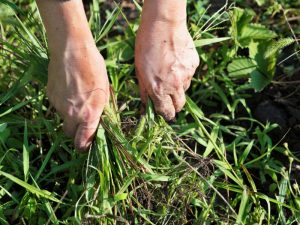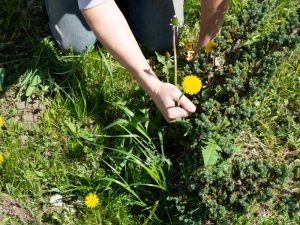Maintaining a vibrant, healthy garden in Sydney comes with challenges, especially when managing weeds. Weeds can quickly take over, competing with your plants for water, sunlight, and nutrients. Identifying the signs of a weed infestation early on is critical to keeping your garden thriving. This article will cover the signs to watch for and how to manage weeds in Sydney’s climate and soil.
What are common early indicators of a weed infestation?
Spotting a weed infestation early can save your garden from damage. Look out for sparse or patchy grass, as sudden bald spots may signal aggressive weeds outcompeting your turf. Unwanted plants that don’t match your garden’s design and weak, drooping plants are other indicators. These weeds may be stealing essential nutrients. If you notice your garden needs more water than usual, it could be because weeds are soaking up extra moisture. You can tackle a weed problem by catching these signs early before it spreads further.
How can you spot weed infestation in different soil types?
Sydney’s diverse soil types create unique conditions for weeds. Here are signs to check for based on soil types:
Clayey soil:
- Slow drainage leads to weeds thriving in wet patches.
- Heavy growth after rainfall, as clay retains moisture.
Sandy soil:
- Weeds spread quickly in areas that dry out rapidly.
- Larger patches of invasive plants that tolerate poor nutrition.
Loamy soil:
- Both native and foreign weeds compete for space due to balanced nutrients.
- Dense, spreading weeds, especially near established garden beds.
How does Sydney’s climate contribute to weed infestation?
Understanding how to control weeds in Sydney’s climate is essential, as the Mediterranean environment significantly impacts the weed growth cycle. Here’s how each season affects infestations:
- Summer (December – February): Hot, dry weather encourages drought-resistant weeds.
- Autumn (March-May): Increased rainfall and milder temperatures promote rapid weed growth.
- Winter (June – August): Weeds survive mild winters, often going dormant until spring.
- Spring (September – November): Warmer temperatures and more rain lead to a resurgence of invasive weeds.
What are the signs of weeds competing with your garden plants?
When weeds begin competing with your plants, it often becomes evident due to a few telltale signs:
- Wilted leaves: Weeds absorb water, leaving less for your plants, causing wilting.
- Yellowing or discoloured plants: When weeds take up too many nutrients, garden plants suffer, and yellowing leaves are a common sign.
- Slowed growth: Plants should start slowing down when weeds steal nutrients and sunlight.

How can sun and shade affect weed growth in your garden?
Sun exposure is essential when identifying weeds, as some thrive in sunlight, while others prefer shaded spots. Here’s what to watch for:
- Sunny areas: Perennial weeds like bindweed or dandelions are fast-spreading weeds that thrive in sunny patches.
- Shaded areas: Look for weeds like ivy or chickweed in more relaxed, shady spots.
- Partial shade: Weeds that adapt well to variable light can often spread into areas with fluctuating sun and shade patterns.
What damage can a weed infestation cause to your plants?
If a weed infestation takes hold, the damage can be widespread:
- Choking growth: Weeds can physically crowd out other plants, limiting their access to light and air.
- Reduced flowering: Plants robbed of nutrients by weeds often struggle to bloom.
- Poor crop yields: Weeds minimise crop size and yield, leading to fewer and smaller harvests for vegetable growers.
Are weeds attracting pests and diseases to your garden?
Weeds often act as breeding grounds for pests and diseases, affecting nearby plants. Look for these signs:
- Increased insects: Weeds attract aphids, caterpillars, and other pests, especially if they provide shelter or food.
- Mildew or fungal growth: Weeds can introduce mildew, affecting moisture-sensitive plants nearby.
- Root rot in surrounding plants: Overly moist soil due to dense weed patches can lead to root rot in nearby garden plants.
Why is weed infestation more likely after heavy rain?
Heavy rain may bring welcome moisture and trigger weed growth, especially in Sydney’s garden environment. Here’s why:
- Moist soil: Wet soil encourages weed seeds to germinate quickly.
- Flooding in clayey soil: Areas with slow-draining soil create ideal environments for water-loving weeds.
- Spread of seeds: Rain can spread weed seeds across your garden, leading to scattered patches of new weeds.
How does regular maintenance help control weed infestations?
Routine maintenance is essential to prevent weeds from establishing. Here are key steps to include in regular upkeep:
- Consistent weeding: Remove weeds before they can seed, ideally every few weeks.
- Mulching: Apply mulch for weed control around plants to reduce open soil space where weeds thrive.
- Soil improvement: Adding organic matter can balance soil conditions, making it harder for weeds to dominate.

When should you consider professional help for a weed infestation?
Sometimes, a weed problem becomes too harsh to handle on your own. Professional help can make all the difference. Signs you may need it include:
- Fast-spreading weeds: Weeds that increase, like couch grass or bindweed, can only be removed with professional intervention.
- Deep roots: Weeds with deep roots, such as dandelions, can be hard to eliminate without specialised tools.
- Persistent pests: Professionals can provide sustainable treatment options if weeds attract persistent pests or diseases.
Why is it essential to address weed infestation before it spreads?
Taking early action can save time and effort later. Here’s why timely intervention matters:
- Prevent seed spread: Removing weeds before they seed helps control their spread.
- Protect surrounding plants: Early weed removal gives your garden plants the resources to grow strong.
- Maintain soil health: Weeds can deplete soil nutrients, making it harder for other plants to thrive.
Keep your garden weed-free and thriving
Tackling a weed infestation early can make all the difference in maintaining a lush and healthy garden. By staying alert to signs—such as patchy grass, wilting plants, or unexpected growth—addressing the signs of a weed problem early on can prevent weeds from overtaking your garden and competing with your plants. Regular maintenance, from consistent weeding to mulching, is essential to keeping these unwanted plants at bay.
If you’re struggling with a stubborn weed infestation, A Bargain Gardener has been servicing Sydney Gardens and Landscapes for over 20 years. With our latest technologies and crafty skills, we are set to spruce up your garden to the best appearance and health it requires in any season. Our team of experts can identify and treat a wide range of weed infestations, ensuring your garden remains healthy and beautiful. Don’t let weeds take over your garden! Transform Your Garden with A Bargain Gardener and watch your garden flourish.


